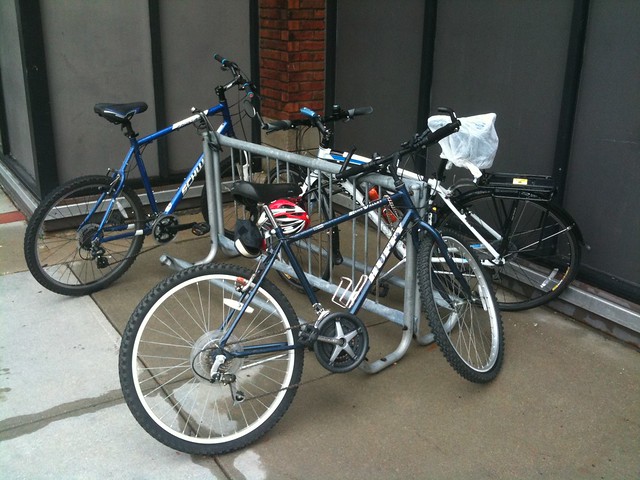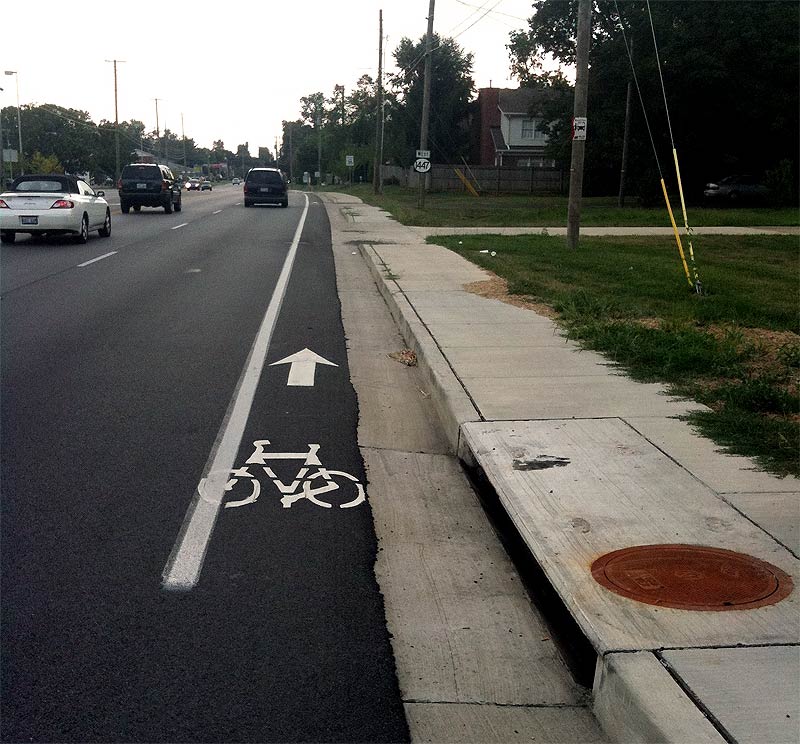Would you build a garage on your house without taking measurements beforehand to make sure your two cars fit? No? Well it seems many planners and designers have taken this approach to building bicycle infrastructure.
Bike lanes like this are beyond useless, they are actually dangerous. These get built because road engineers read standards calling for minimum width of bike lanes to be 3 feet. So they measure 3 feet from the curb’s edge and call it a day. The greatest irony is that by today’s increased traffic and faster road standards, engineers would never design a street so narrow that cars would be forced to drive in the curb gutter, yet this is perfectly acceptable for bikes.
Even if they did, the uneven paving surface that occurs at the asphalt-concrete seam would be no problem for a car, so its not even given a second thought. But for a bicycle, this seam can be as dangerous as riding parallel along in-street train tracks. A newly paved lane like this is marginal at best. As soon as the pavement is subjected to the temperature changes of s few seasons, potholes will form around the seam, making it even more treacherous for bike riders.
Curb gutters also the natural collecting place for road debris—gravel, wet leaves, or broken glass—that’s not very conducive to bike riding. Furthermore, large storm drains like the one in the photo not only create dangerous changes in surface grade, but they make virtually assured that the bike lane will be underwater during anything but the lightest of rain showers.
The problem of deficient bike infrastructure extends beyond public facilities. Well-intentioned businesses often buy “bike racks” which are more a waste of space than any help to bike-riding customers.

These “grill” bike rack can be seen many places around the city. They give most non-cycling business owners and community members a false sense of bike-friendliness. Yet any bike rider will tell you how aggravating and generally useless they are. You can see in the picture, this rack ostensibly has slots for eight bikes. Even if that were the case, this rack is placed too close to the wall to use the back side of it properly, so four spaces are already lost.
Furthermore, eight spaces assumes that you can simply put your front wheel into the grills, which doesn’t allow a bike owner to lock anything but their front wheel to the rack, unless you use an rather long cable lock. These sorts of long cables are notoriously quick fodder for the bike thief’s bolt cutters, or impractically cumbersome because of the extremely heavy gauge required to resist theft.
A correctly designed bike rack always provides a simple way to lock your bike’s frame directly to the rack with a U-lock. With a rack like the above, in order to lock bikes securely, a rack “designed” for eight bikes, only accommodates three and takes up as much space as five “staple” racks (pictured below) that securely park 10 bikes would.
Fortunately as more people, businesses, and governments realize that biking is an overwhelming rational mode of transportation, they will be forced to correct their misconceptions about what constitutes sufficient bike infrastructure. In the meantime, it helps to remind elected officials and business owners what’s functional and what’s not.




Thanks for noticing the absurd situation on Westport Road, which was widened from two lanes just within the past few years at a cost of millions. Only a small part of the project has bike lanes at all.
The really painful thing is that, at the same time the road was being built, the state highway department was also building its new regional offices on that very road (the part without bike lanes no less).
So it appears the very ones who are in the position to effect positive change just don’t get it.
I ride the section of Westport Road from just east of the bike lanes out to beyond the Ford plant almost daily, and have little trouble with motorized traffic.
I ride the section with painted shoulders/gutter areas once in a while, and tend to think of it as such rather than as a bike lane. Despite that I have more trouble with motorized road users, I see no reason why I cannot consider that painted stripe as merely a fog line, since the supposed bike lane is clearly more hazardous to me than somewhat-slowed traffic behind me. If I’m using that shoulder/gutter, traffic passes me at hyperlegal speeds with little room. If I’m in the main travel lane, some traffic passes at 60+mph in the left lane, but some are compelled to slow enough behind me that they can only get up to 35 or so as they pass me (the posted speed limit is 45).
I had some discussions with the folks in Louisville Metro Government about the time these horrid things were being painted, and suggested that it would really have been better to leave out (and thus not have to pay for) the bike logos on the roadway and the “bike lane” signage. I pushed for signs that read “Bikes May Use Full Lane” instead of the insipid “share the road” markers.
You see how far that got.
Yes, this is a fine example of bike lane built to expedite motorized traffic. Nothing more.
The crappy bike rack that is subject to so much well-deserved criticism is at the Kroger located near the intersection of Hubbards Lane and Westport Road, if readers don’t recognize it. I’ve locked to and beside that rack a number of times. Since there are rarely more than three or four bike users patronizing Kroger at any given moment, it’s not as big a deal as it might be, although the flip-side of the argument is exactly what you point out–the crappy rack discourages bike users from going to Kroger.
Several folks who buy stuff from Kroger don’t let the crappy rack deter them. We just figure out other ways to keep our bikes in our ownership.
@Tom Armstrong – I’m also very concerned on how the seams are going to weather. That said, for the time being, I feel like the lane is useful to a narrow cross section of cyclists who are both expert enough to be comfortable with high speed traffic, but dumb enough to ride a line about 6″ from the left edge of the gutter seam. That currently includes me, but not anyone else as far as I can tell.
The point is to show that bicycling is not in demand. “Look, nobody is using this wonderful facilty we built, let’s stop trying”.
@Dave M. –
You are exactly right. “If they (we) don’t use it, we don’t have to build another!”
I called Metro Call roughly weekly asking that the bike lane be swept. I think I noted that some of the debris had been moved around a bit, suggesting that something with a broom went by there one day (although the broom may have been several inches above the pavement at the time).
Like you, I pointed out the real potential for the asphalt/concrete seam to create problems. My contact within LMG is also a cyclist, and agrees with me. He tells me that he pointed out this issue in discussions with the state’s engineers, but got overruled.
I would really prefer that the whole bike lane be scrapped, and tell the motorists to slow down a bit. Put “Bikes May Use Full Lane/Change Lanes to Pass” signs up all over the place. ENFORCE the stinking speed limit (the 25 speed limit posted during the construction phase was never enforced, either).
@Tom Armstrong – Absolutely right about the rack Tom. The bike with the bag on the seat is mine. I disagree, though, that the rack is sufficient. Nearly every time I’ve gone to Kroger in the past 3 months there have been at least 2 bikes locked to the rack and one locked to a tree in an island across from the entrance, as well as the occasional bike locked to other random post-shaped things near the entrances.
@Erik Weber – You’re right, Erik. I was not good at phrasing my comments as to be paraphrasing the store’s outlook. I think I even refer to the existing bike rack as crappy in the rest of my post–which is certainly my opinion of the thing.
You and I agree that the rack is not nearly good enough to encourage more use–I add that more determined riders will find other ways regardless of the crappiness of the rack, or find other grocers to patronize (I’m fond of ValuMarket on Whittington Parkway, but Kroger is sometimes closer to my travel path). It seems more an afterthought bone tossed our way than a real invitation to shop there. During the store remodel several months ago (a year?), there were storage units blocking the walkway between the rear parking lot and the subdivision behind the store (Westport Terrace?). The store front doesn’t lend itself to a proper rack, either, as I suspect you would also agree.
I think that an employee locks his bike to that tree. I’ve seen the same bike there (or one that looks VERY much like the same bike) fairly often.
@Tom Armstrong I too have ridden the entire stretch numerous times with “little” trouble. In fact I am constantly amazed at the courtesy shown me by “most” drivers.
The problem is with the “little” trouble. It only takes one driver to cut a little too close to do me in. And he seems to be out there each time I am … and narrowing the margin each time he passes me.
I’m over 50 and thus feeling more mortal than most twenty-somethings. And there are things I want to do with my life before becoming a martyr to the cause. So I admit that when traffic is heavy I retreat to the (very narrow) sidewalk. It’s illegal but it works, since there are even fewer pedestrians than bicyclists.
I certainly support rattling a few cages here … for better signage or wider and consistent bike lanes. And I’ll do my part. But it looks like it will take some organized collective action to have an effect.
@John Hicks – I turned 50 earlier this year. I have no illusion of immortality, either. However, I do seem to have something of a chip on my shoulder when it comes to lane rights, and it intimidates a few motorists from time to time. I “ride large” when on my bike, to make myself more visible from farther away. I don’t give them any excuse for claiming to not see me (there are exactly two reasons why a motorist would not see me on the road, and both are the motorist’s fault).
@Erik Weber –
Erik, this is a perfect illustration of how cycling solutions get distorted in a car-centric world. I’d like to include this photo on an upcoming web page about impediments to carefree cycling–but only with proper attribution.
My I use it? If so, how do you want it attributed?
Thanks,
Bob Forgrave